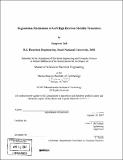Degradation mechanisms of GaN high electron mobility transistors
Author(s)
Joh, Jungwoo
DownloadFull printable version (9.632Mb)
Alternative title
Degradation mechanisms of GaN HEMTs
Other Contributors
Massachusetts Institute of Technology. Dept. of Electrical Engineering and Computer Science.
Advisor
Jesús A. del Alamo.
Terms of use
Metadata
Show full item recordAbstract
In spite of their extraordinary performance, GaN high electron mobility transistors (HEMT) have still limited reliability. In RF power applications, GaN HEMTs operate at high voltage where good reliability is essential. However, physical understanding of the fundamental reliability mechanisms of GaN HEMTs is still lacking today. In this thesis, we carry out systematic reliability experiments on industrial GaN HEMTs provided by our collaborators, TriQuint Semiconductor and BAE systems. In our study, GaN HEMTs have been electrically stressed at various bias conditions while they are being characterized by a benign characterization suite. We have confirmed that electrical stress on devices results in an increase in drain resistance RD and a decrease in maximum drain current IDmax. During the stress, traps are found to be generated. We have seen that this degradation is driven mostly by electric field, and current is less relevant to electrical degradation. (cont.) From a set of our experiments, we have hypothesized that the main mechanism behind device degradation is defect formation through the inverse piezoelectric effect and subsequent electron trapping. Unlike current conventional wisdom, hot electrons are less likely to be the direct cause of electrical degradation in the devices that we have studied. Our studies suggest a number of possibilities to improve the electrical reliability of GaN HEMTs.
Description
Thesis (S.M.)--Massachusetts Institute of Technology, Dept. of Electrical Engineering and Computer Science, 2007. Includes bibliographical references (p. 83-85).
Date issued
2007Department
Massachusetts Institute of Technology. Department of Electrical Engineering and Computer SciencePublisher
Massachusetts Institute of Technology
Keywords
Electrical Engineering and Computer Science.